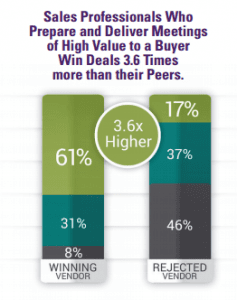 The “moment of truth” for B2B sales reps selling complex enterprise solutions involving multiple stakeholders is the time presenting and interacting with customers. A recent Richardson Training whitepaper stated, “Sales Professionals who prepare and deliver meetings of high value to a buyer win deals 3.6 times more than their peers.” In today’s digital environment, senior buyers and key recommenders are knowledgeable about vendor offerings and only accept sales meetings with supplier reps they believe will add value to their evaluation process. According to The Challenger Sale, “77% of B2B purchasers say they won’t even speak to a salesperson until they’ve done their own research.” How do highly successful reps approach initial customer meetings?
The “moment of truth” for B2B sales reps selling complex enterprise solutions involving multiple stakeholders is the time presenting and interacting with customers. A recent Richardson Training whitepaper stated, “Sales Professionals who prepare and deliver meetings of high value to a buyer win deals 3.6 times more than their peers.” In today’s digital environment, senior buyers and key recommenders are knowledgeable about vendor offerings and only accept sales meetings with supplier reps they believe will add value to their evaluation process. According to The Challenger Sale, “77% of B2B purchasers say they won’t even speak to a salesperson until they’ve done their own research.” How do highly successful reps approach initial customer meetings?
Top B2B sales reps differentiate their offering starting early in the sales process by coming prepared to engage customers in a conversation about business outcomes that clearly resonate with senior buyers. High achiever reps know B2B sales cycles for complex solutions are lengthy so qualifying solid opportunities first creates a competitive edge. It’s a fact the best reps always have a higher number of qualified deals in the pipeline compared to their peers.
So what are these “A-player” reps doing different? Top reps know senior buyers want to hear, “What do you do for your customers?” instead of a 45 minute standard pitch. So while competitive reps are presenting 30+ PowerPoint slides about their company and products, or, even worse, expect attendees to answer a series of questions about pain points, evaluation criteria, budget, provide data based on a vendor qualification template etc. the “A-players” consistently do three things:
- Proper Preparation: Credibility is established quickly with meeting attendees when the rep confidently speaks directly to issues facing “typical customers” in the same industry, and, providing “business insights” how customers have addressed these issues.
- Focused Messaging: Business outcomes are addressed by communicating and showing tangible results achieved by “typical customers” from cost savings, revenue increases or reducing risk based on business assumptions for customers “similar to you”. The rep creates trust with the audience when he/she “knows our business” and what drives successful outcomes impacting financial results.
- Engages Customer in a Business Conversation: Based on typical customer situations using example data, reps know when meeting attendees start asking questions specific to their situation and the rep is in listen mode, the selling process has commenced. High performance B2B reps know conversation around value vs. price is the first step in qualifying a real opportunity.
Please notice from above habits of highly successful reps, presenting your company overview, product features, showing customer logos, office locations etc. are NOT addressed before knowing if key attendees become positively engaged in a vision for success similar to your successful customers. Exact data is not required or recommended early in the sales processes as leading reps know approximately 75% of a normal 6-18 month sales cycle involves vendor and customer “experts” evaluating and proving similar results can be expected for “our company”.
A vast majority of B2B sales “superstars” I come across have confidence in their outstanding pre-sales technical resources and subject matter experts who effectively collaborate with customers entering the sales process. Rockstar pre-sales professionals welcome working with top reps on qualified sales opportunities as they know their deals experience the highest probability to close. Conversely, non-qualified sales opportunities transitioned to pre-sales are costly, take away valuable resources from qualified opportunities and stagnate in CRM before ending in “no decision”.
How can Sales Management replicate A-player behavior with core reps encompassing 80% of the sales force?
Typical customer Value Propositions presented by reps early in the sales process is the #1 way sales reps grow top line revenue. Visualize all your “middle of the salesforce reps” targeting new accounts and selected customers by:
- Proactively addressing the question, “What do we do for our customers?”, via a typical value proposition for “customers in your industry”.
- Showing expected ROI and TCO results based on relative business drivers for their industry.
- Identifying data assumptions used in a typical value proposition and getting more customers to request a “next step” to explore revising data to resonate closer to the buyer’s situation.
- Gaining a competitive edge by qualifying the sales opportunity first and engaging top-notch presales teams into the process before competition.
- Selling collaboratively with customers on value instead of primarily price.
Increasing sales opportunities focused on customer value entering the pipeline on a consistent basis closes more deals by assigning higher quality opportunities for collaboration with pre-sales professionals, reduces sales cycles by getting a jump on the competition, lowers discounts by focusing on customer value and increases profitability. Just think about the increase in revenue (and commissions) if 80% of reps each added a single new qualified opportunity in their forecast over the next 12 months.

